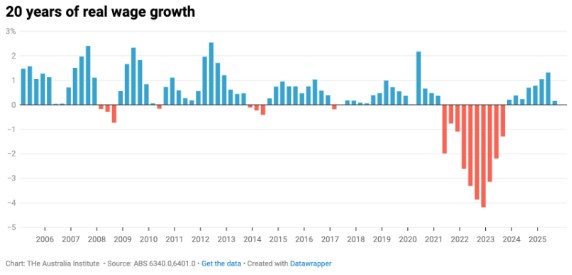The latest figures from the Australian Bureau of Statistics show wages are growing at a reasonable rate, but a deeper look shows a big problem might be about to bite Australian workers.
The Wage Price Index was released on Wednesday and is a measure of how fast wages are increasing.
It showed that wages increased 3.4 per cent over the past year, the same as the annual increase from last quarter.
An annual growth rate of 3.4 per cent is reasonable. The long run average is 3.1 per cent, so it’s slightly above average.
However, as the graph below shows, the growth rate in wages has fallen since it peaked at the end of 2023.

The Reserve Bank will certainly be happy, as it firmly believes that higher wages are a cost for businesses, who will push up prices in order to protect their profits. For the Reserve Bank, higher wages lead to higher inflation.
Is the cost-of-living crisis over?
Not so fast. Wages growth is only part of the picture. What people should really be focused on is what economist call real wages.
Real wages is a measure of how much stuff you can buy with your wage.
This takes account of not just how much your wage has increased by but also how much the prices of the things you buy have gone up by. Inflation is usually measured by the consumer price index.
Let’s use a simple example. Imagine wages have risen by 5 per cent. That’s a big increase in wages.
Workers must be really happy. But if inflation, the prices of the stuff people are buying, has increased by 10 per cent, then workers are actually worse off.
Sure, their wage went up, but prices have gone up even faster. This means they can now buy less stuff.
In this example, real wages have actually fallen by 5 per cent (5 per cent wage rise minus 10 per cent inflation rate). When real wages fall, that is when people feel the cost-of-living pain.
So, what are real wages at the moment? That the WPI increased by 3.4 per cent doesn’t look as great since inflation in the same period was 3.2 per cent. Real wages were only up 0.2 per cent.
The graph below shows real wages over the past 20 years. We can see that most of the time they are positive.
Before 2022 it was very rare to see people’s real wage go backwards. After 2022 we saw a huge fall in real wages, the largest and longest we have seen in recent history.

This was the period when households felt the financial squeeze. That is exactly what falling real wages mean. People can buy less stuff with their wage.
At the end of 2023, real wages started growing again. Things were finally improving. But in the latest quarter that has changed dramatically.
Real wages have fallen from 1.3 per cent to only 0.2 per cent. Still positive but only barely.
Does this signal the beginning of a new cost of living crisis?
While it appears unlikely that wages are going to grow faster in the near future, the fall in real wages is because of a big increase in inflation in the last quarter. This was driven mainly by temporary factors, like the drop in state government electricity subsidies.
If inflation doesn’t increase further and wages continue to grow at the same rate, then real wages should stay positive.
You might have noticed there are a few ifs in that statement. Things can change quickly, and we don’t have a lot of wriggle room.
Making the whole thing worse is the Reserve Bank hovering in the background, sounding the alarm and threatening to put up interest rates anytime wages look like they might grow at a decent rate.
This is made all the more galling by the fact that at the same time it is worrying about wages growth, it is seemingly unconcerned about the rapid growth in corporate profits.
Higher profits can also push up prices, a fact the Reserve Bank is happy to ignore.
Growth in real wages has slowed to a crawl. Hopefully things will pick up, otherwise we might be in for another rocky ride.
Between the Lines Newsletter
The biggest stories and the best analysis from the team at the Australia Institute, delivered to your inbox every fortnight.
You might also like
If business groups had their way, workers on the minimum wage would now be $160 a week worse off
Had the Fair Work Commission taken the advice of business groups, Australia lowest paid would now earn $160 less a week.
The continuing irrelevance of minimum wages to future inflation
Minimum and award wages should grow by 5 to 9 per cent this year
What have the scientists ever done for us?
Australian scientific discoveries have improved people’s lives and made the economy more productive – so why is the CSIRO being forced to shed workers again?




